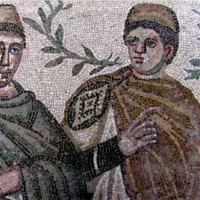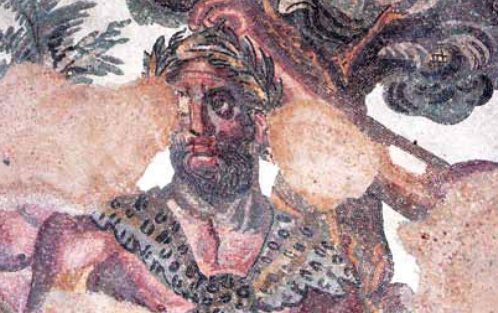- Details from the Great Hunt mosaic show two men associated with the ownership of the villa.
- Details from the Great Hunt mosaic show a hunting scene depicting the live capture of animals, perhaps for games in the arena. Here, a glass sphere is used to catch a tiger.
- The apotheosis of Hercules is shown in these details of the triclinium mosaic. Other deeds of Hercules depicted or alluded to in the mosaic include the slaying of the Nemean lion, the Hydra of Lerna, and the Stymphalian birds; the capture of the Cretan bull and the cattle of the monster Geryon; and the cleaning of the Augean stables.
- The capture of the mares of Diomedes is shown in these details of the triclinium mosaic. Other deeds of Hercules depicted or alluded to in the mosaic include the slaying of the Nemean lion, the Hydra of Lerna, and the Stymphalian birds; the capture of the Cretan bull and the cattle of the monster Geryon; and the cleaning of the Augean stables.
The Villa del Casale, near Piazza Armerina in south-central Sicily, is arguably one of the best-preserved and best-known Roman villas, iconic of the villa form as it developed during the late empire (4th and 5th centuries AD). The villa contains one of the most important collections of late Roman mosaic pavements in the Mediterranean, with its most notable phase in the early 4th century. While the archaeological excavation of the villa, carried out first in the 1950s and sporadically in the 1980s and 1990s, was concerned almost entirely with these mosaics, other questions—about its agricultural apparatus, its chronology, and its post-Roman occupation— have been largely ignored. New excavations carried out since 2004 by the Università di Roma “La Sapienza” have resumed work on the villa and made possible a comprehensive study of the earlier archives. This new work has revealed the complexity of the villa’s decoration, including its marbles and frescoes. It has also uncovered more of the villa’s residential sectors, and revealed a whole new life-phase—a large medieval village settlement that grew atop the villa during the 10th through 12th centuries.
The Villa
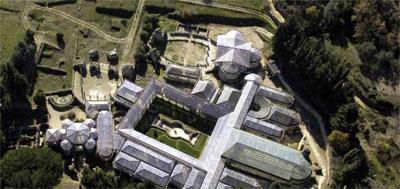
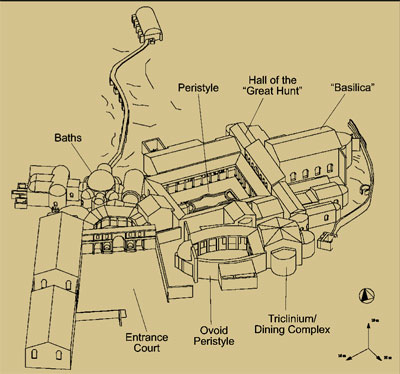
The Villa del Casale constitutes one of the grandest examples of a late antique Roman villa. Architectural and decorative elements found in other contemporary villas throughout the western empire are combined here with unparalleled richness and complexity, a complexity which in turn suggests a villa with many varied functions. Indeed, the study of later Roman villas in recent years has underscored the degree to which these great buildings were not only residences, but also public spaces: centers of political and administrative power for the territories in which they resided. Thus, the trends in late Roman architecture impacted not only urban houses but also rural ones, both types reflecting the new social practices of late Roman aristocrats. Now such elites preferred to conduct their affairs in their private residences, building great spaces for receptions (audience halls or banquet halls), which increasingly took on an official, that is to say, public character. As a consequence, public buildings ceased to be the stage sets against which elite competition took place, competition that instead migrated to the house, where the use of public architectural vocabularies—such as columns, revetments, and mosaics—began to proliferate and became ever more important.
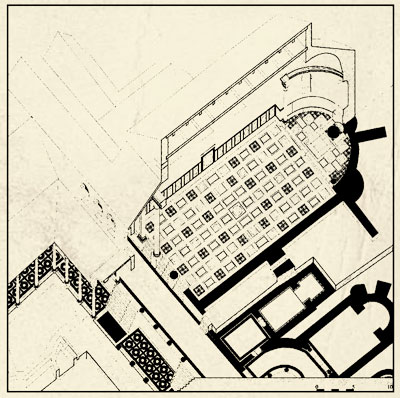
The Villa del Casale is spread out along three great terraces at the foot of a hill. Most unusual for such villas, it is organized around three different axes. To the east lies the first terrace, bounded by an aqueduct and containing private apartments, the basilica, and the corridor of the so-called Great Hunt. From here one moved to the second terrace centered on a rectangular peristyle courtyard that included a triclinium (dining room) complex and its oval courtyard, both accessible from the corridor of the Great Hunt. The third terrace was composed of the baths and the monumental entrance to the villa marked by a tripartite, niched arch.
This late Roman building developed atop an earlier villa. Excavations suggest the early building was also organized around a central peristyle, had a bath complex, and occupied more or less the same area as did the late antique structures that were built atop it in the 4th century. Recent excavations indicate that the earlier villa probably originated in the 1st century and persisted through the second half of the 3rd century.
The Mosaics

It is for its mosaics that the Villa del Casale is justifiably famous. Stretching over some 3,500 square meters, these mosaics reflect themes common to the era, using both direct and symbolic means to laud the dominus, or landowner. The mosaics also reflect themes appropriate to the rooms in which they appear. Thus, although much previous scholarship tended to consider them in isolation, there is a fundamental relationship between the pavements and the architectural contexts in which they were set.
It is also important to note that arguably the grandest space in the villa—the great basilica—does not have a mosaic floor, but rather was paved in opus sectile, or large slabs and roundels of cut marble. This fact is instructive: it was marble, not mosaic, which constituted the material of greatest prestige in the Roman world.
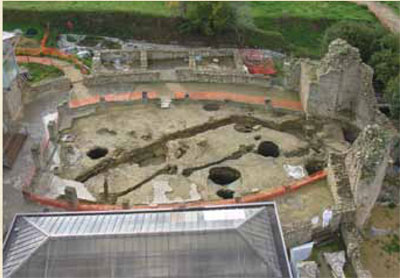
As one considers the mosaics of the reception areas, the most striking piece is the corridor of the Great Hunt, in which a long hall capped by apses at each end was covered with scenes of the hunt, capture, and transport of animals. In the apsidal ends appear female personifications of both the province of Mauretania, with a bear and a leopard, and the land of India, shown holding a tusk and surrounded by a tiger, an elephant, and a phoenix. In the hunt mosaics one can recognize a depiction of the port of Carthage, the departure point for the caged beasts; an arrival port on the Italian coast, perhaps Pozzuoli or Portus; and even the port of Alexandria and an Egyptian landscape marked by pagoda-like buildings along the Nile. Another landscape scene of rocks and forests, also identified as Egyptian, is associated with a depiction of two soldiers flanking a bearded man who wears a uniform and a so-called Pannonian hood and carries a rod identifying him as an authority figure—perhaps the dux or military leader of the province or the conductor of the hunt. An extraordinary method of hunting tigers around a sphere of glass, described in 4th-century sources, is shown in another scene depicting the capture of Indian animals and their caging and transport to ships.
The Great Hunt scene is now generally interpreted as an allusion to the high rank of the proprietors, who may actually appear in the mosaic—one as a bearded man in the lower level and another, younger man depicted in the center of the composition. These landowners are thus shown supervising the capture of animals destined for the venationes, or beast-spectacles.
The other large reception space was the nucleus composed of the great tri-apsidal hall or triclinium that opened onto an ovoid peristyle. This complex was connected to the villa by two small and irregular courtyards, one that led from the Hall of the Great Hunt, and another from the peristyle. This fact has led some to suggest that the oval peristyle complex was built after the rest of the villa, a supposition supported by the different style of the complex’s mosaics and, above all, by the latest excavation results. The facial expressions, the backgrounds, and the complex figural compositions of the mosaics all point to an artistic tradition with closer ties to Hellenistic iconographies, versus the African style of the other mosaics. Indeed, the mosaics of the great triclinium, covered with scenes relating to the Labors of Hercules, are dramatic in tone, using large-scale figures.
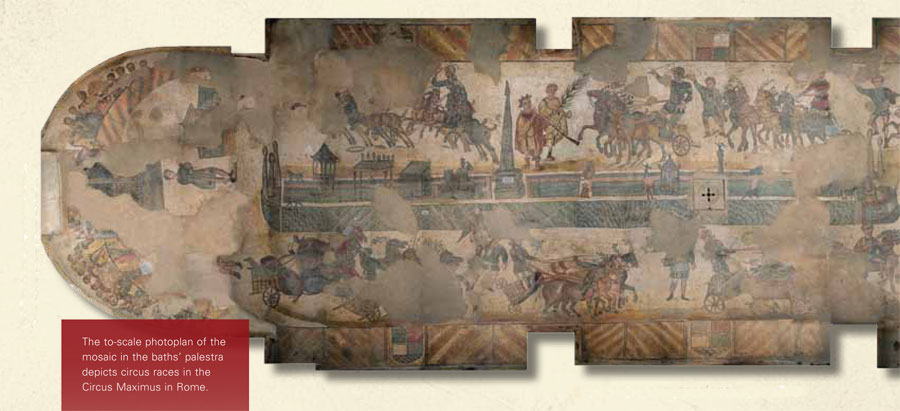
The apotheosis of Hercules in the triclinium has Dionysiac qualities, such as the crown of ivy leaves and the panther skin. Dionysiac themes—the harvesting and crushing of grapes, carried out by amorini or baby cupids—are also common in scenes in the rooms at the side of the peristyle. Other references to a Bacchic cult appear in many mosaics in the villa: in the thiasos or procession of Adriadne where the hippocamps (seahorses) wear panther skins; in the contest between Eros and Pan, where maenads and satyrs are in attendance; and in the frescoes that include a scene of Dionysius. While such Dionysiac motifs are common in late antiquity, their frequency here, combined with the unusual move of providing Heracles with such motifs, suggests a particular devotion to the god of wine.
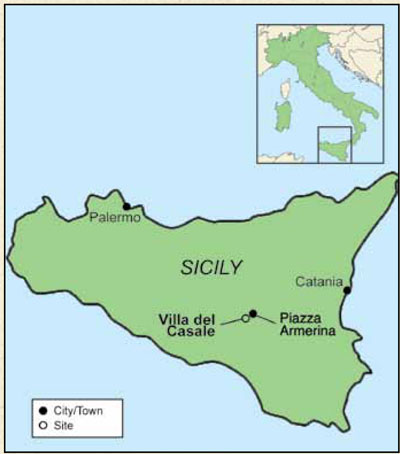
Another major theme is the circus games and athletic competition, particularly visible in the mosaics of the palestra, or gymnasium, in the baths (See page 29). Here the depiction of the Circus Maximus in Rome is presented from the bird’seye view of a spectator seated in the imperial tribunal on the south slope of the Palatine Hill. This is evident from the orientation of the statue of Magna Mater, placed on the center-line of the circus, which is shown from the back. From the carceres or starting gates, four charioteers emerge representing the four factions, or racing clubs—the prasina (the greens), the veneta (the blues), the albata (the whites), and the russata (the reds)—while four chariots are shown racing on the track. In the central space of the circus are shown several moments of the same race, including a crash and the arrival at the finish line.
Other aristocratic elements of the games are visible in some of the villa’s most famous (or infamous) mosaics, which also date to a second phase, after the mosaics of the peristyle and Great Hunt. New scenes replace earlier geometric scenes and one depicts the famous “Bikini Girls,” an athletic scene with scantily clad women. Scholars now accept that the scene depicts an athletic competition (previous theories favored a beauty contest), examples of which are attested even in 4th century sources, but the significance of such competition again relates to elite status. The sponsorship of female athletic contests would have been associated with only the highest levels of society and thus reflected upon the elevated status of the proprietor.
The Frescoes
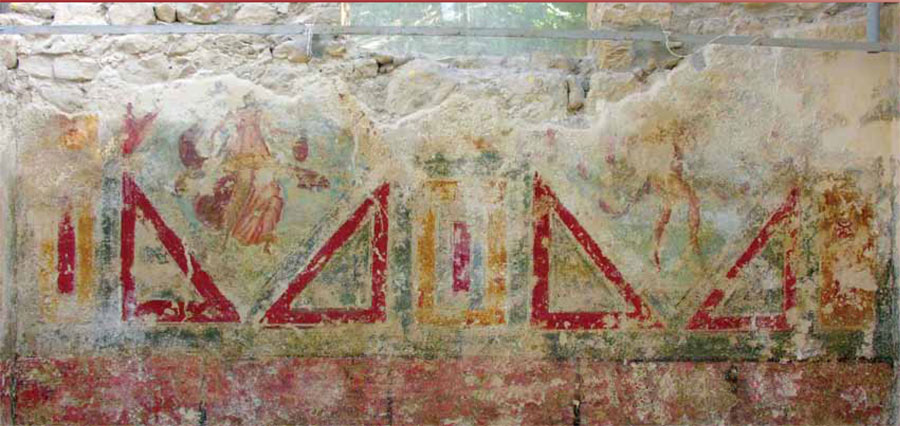
Although less well-known than for its famous mosaics and marbles, the Villa del Casale also boasts an amazing collection of mural paintings that covered the walls of the residence. These are rarely considered in the many studies of the site, but given the paucity of late antique domestic wallpainting, the examples at Piazza Armerina are an important corpus and form a critical part of the total decoration of the villa complex.
Perhaps most extraordinary is the fact that these paintings covered not only the interior rooms but also exterior walls, frequently depicting imitations of marble revetments. One exterior painting appears on the long walls that formed the entrance court of the villa, where a scene depicts four larger than life-size figures, accompanied by military insignia, who are preceded by a sequence of men on horseback.
The Villa’s Owner
Most scholars believe that the late antique phase of the villa dates to the early decades of the 4th century, and recent excavations generally support this. But as the style of the mosaics suggests, and our new work has confirmed, this phase is followed by later additions—perhaps after the AD 365 earthquake—including the oval peristyle, the triple-arched entrance, and the external painting near the entrance.
Various historical personages have been proposed as the owner of the Villa del Casale. The great size of the basilica, the imperial viewpoint depicted in the Circus Maximus mosaic, the presence of animals associated with the emperor, such as the griffon or elephant in the Great Hunt, the figure of Hercules in the triclinium, the Tetrarchic military insignia in the entrance, and the likely Tetrarchic date of the mosaics have all led scholars to posit an imperial owner: Maximianus Herculis (co-emperor with Diocletian), Maxentius, or even an imperial procurator, or land manager. However, it is important to recognize that many of these symbolic associations were not exclusive to emperors: the marble-covered basilica was a typical element in domestic architecture in the 4th century, while the viewpoint of the Circus mosaic does not exclude other impresarios, such as magistrates. Today it is generally accepted that the villa was the property of a high-level senatorial aristocrat and that it served as the center of a great estate (the massa Philosophiana, known from the Antonine Itinerary) whose lands were to be found nearby.
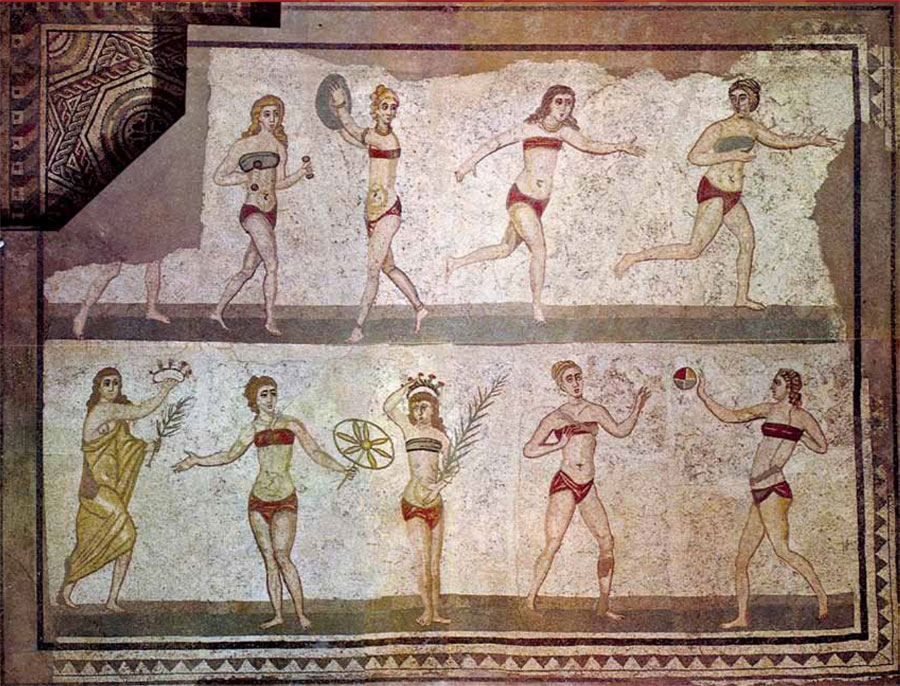
It has been wrongly assumed that the villa was simply a seasonal residence, because no agro-industrial quarters had been located. The absence of an agricultural sector was almost certainly a product of the absence of excavation in the area surrounding the residential nucleus. Indeed, recent excavation has revealed two very large rectangular storerooms, divided into three aisles by brick piers. These storerooms lined one side of the great entrance complex and find parallels in other villas, including some near Rome.
The rebirth of the villa in the 4th century should be seen in light of the resurgence of Sicilian agriculture in that period. Deprived of grain from Egypt, now diverted to the eastern provinces and to the newly founded Constantinople, Rome looked to the south. One suggestion posits that the proprietor may have been an urban prefect of Rome; in addition to supplying the city with grain—now increasingly drawn from Sicily—that official was also charged with organizing the city’s games, a duty perhaps alluded to in the Great Hunt scene. Thus, C. Ceionius Rufus Volusianus, urban prefect and consul under Maxentius and Constantine, and owner of great estates in Africa, and his son, M. Ceionius Rufus Albinus, consul in AD 355 and urban prefect, have been proposed as likely proprietors. This would help explain the heavy influence of North African traditions in most of the mosaics.
The Medieval Phases
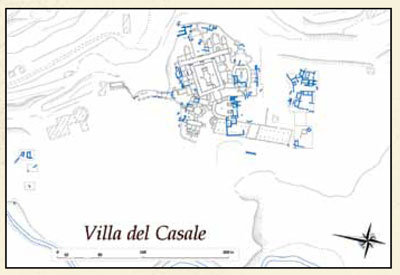
It is likely that from the 7th century onwards, the villa’s buildings were partially transformed. The discovery of many lamps, some with Christian symbols, inside the frigidarium of the baths has led us to hypothesize that this space was eventually used as an oratory. The progressive accumulation of debris over the residence—one of the facts that permitted the excellent preservation of the mosaics—meant that only certain sectors were maintained, while in other cases, new residential structures were built that show no connections with the earlier buildings. This situation continued through the Arab-Norman period, between the 10th and 12th centuries, when the settlement exceeded the limits of the old villa, extending to the north and south towards the Gela River. This settlement consisted of modest houses of stone and earth, most of which had a main rectangular room around which were organized minor spaces either isolated or connected by irregular corridors. Atop this settlement would develop a center known in the 15th century as casale, or farmhouse, from which the site now takes its name.
The Medieval Ceramics
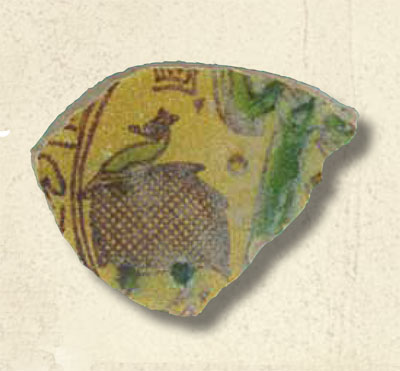
The material culture of the Arab-Norman period is particularly interesting and reveals the wide cultural and economic territory to which the site was linked during the Middle Ages. The evidence from the new excavations has shown the strong connections that bound Sicily and North Africa from the early Fatimid period (second half of the 10th century to the early 11th century) through the 12th century—common ceramic production technologies, aesthetics, and trade relationships. An abundance of burnished and glazed wares for table, cooking, and storage use was found in the medieval settlement. Bowls, basins, cups, storage jars, bottles, and jugs with filters were all commonly found in these small houses. The latter pieces, characteristic of African production but also common in Sicily, were containers for liquids: the neck possessed a sieve formed of numerous punctures and incisions that served as both strainer and decoration. Many types of bowls and basins were found, the largest of which may have been used as communal plates, set at the center of the table, for the sharing of food. Plain table wares and lamps also appeared in decorated versions, the most precious of which had monochrome or polychrome lead glazes depicting geometric and floral forms.
Recent Work
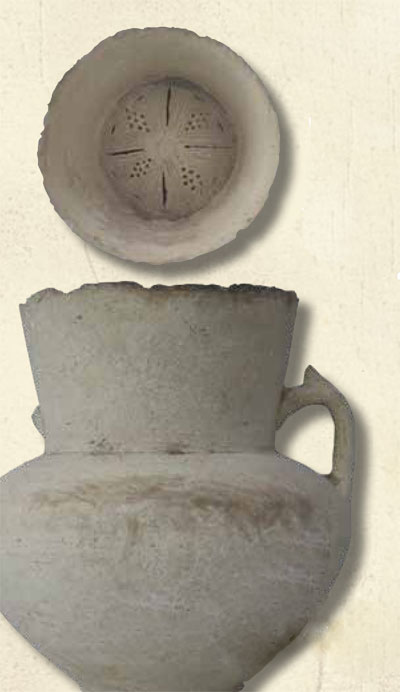
The new excavations were initially focused on the south of the villa, revealing a portion of the Arab-Norman settlement, including houses and artisanal quarters for ceramic production. These buildings were only a small portion of a much larger medieval settlement that had once covered the entire area of the villa, but which was destroyed by the previous excavations which sought only the mosaics beneath. The attempt to preserve these medieval structures for public view has slowed the pace of excavation, which nonetheless has also revealed Roman structures beneath. Indeed, a second bath complex was found close to the storerooms at the entrance. It dates to the late antique phase and shows rare wall mosaics— unusual in the villa—which belong to a basin or a fountain. This work has revealed how little is known of the extent of the late antique phase of the villa. The continuation of the excavations will hopefully uncover further Roman structures, and above all, well-preserved stratigraphy documenting both the use and abandonment of the villa.
Restoration Project
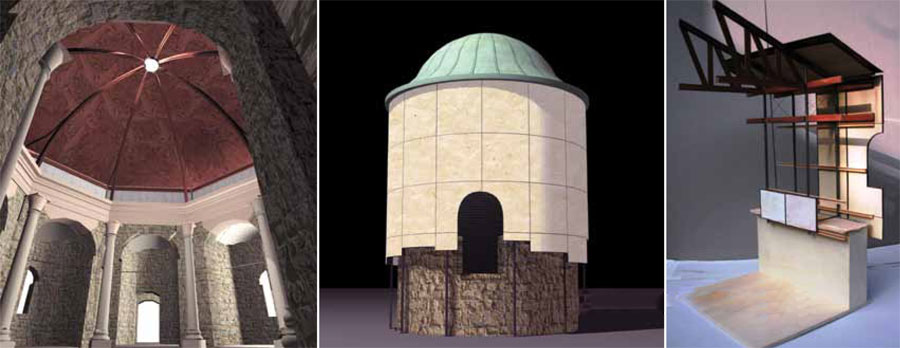
Alongside the excavations, beginning in spring 2007, a major reconstruction project was launched throughout the villa, financed by the European Union. Aside from the mosaics, which needed major conservation, the project also began the replacement of the plastic cover over the site, built in the 1950s by architect Franco Minissi. Considered innovative for its time, the cover allowed for the mosaics to be conserved in situ, rather than being removed to a museum. This method, however, did not foster optimal conservation for the mosaics or for the surrounding architecture. A new project has begun in which the transparent cover will be removed and replaced by a solid roof. The elevated walkways will be maintained, providing an above-ground view of the mosaics over the original villa walls.

